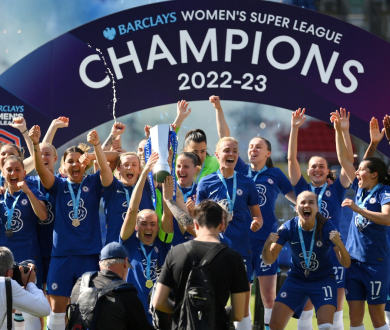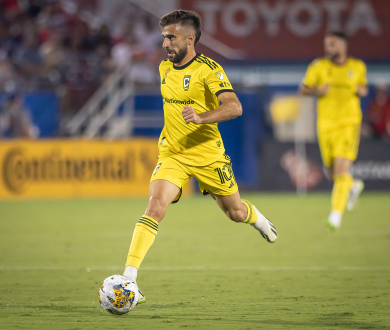
The Growth and Confusion of the Medical and Performance Function
Why having a leader overseeing both departments can remove the doubt
Each season brings a new sense of optimism for owners, general managers, head coaches, and the wider staff inside of an organization. It presents an opportunity for a franchise to unveil its new roster, a collection of new stars acquired through the draft, trade, or free-agent market. Key decisions regarding the direction and level of investment in the team will have been carefully planned, debated, and executed over a number of days, weeks, and months with the aim to positively impact the team in the short, medium, and long term. For some, the timeline to win will have been accelerated while for others, a new beginning will take place. Irrespective of the ‘’time to win’’ predicament, there is an expectation that the organization continues to evolve, demonstrating clear signs of progress whether it be the development of the team’s core stars, an increase in wins per season, or achieving a playoff run.
To achieve any of the above though, you first need to establish a cohesive, collaborative, and communicative structure that is aligned with what the strategy is which will therefore allow leadership to define what the objectives should be. Secondly, there is an understanding that in order to execute the defined objectives, the organization will need its athletes available to execute and achieve the desired outcome. Add to the fact that team valuations have grown exponentially within the last five years MLS (+123%), NFL (+77%), NBA and NHL (+73%), and the MLB (+34%), and player contracts have increased in deal length and value, the need for clarity on the plan and certainty on the decision-making process has only taken on greater significance in the world of elite sport. One area in particular in which organizations have sought to create competitive advantage and drive outcomes in the areas above is within the medical and performance departments, but there still remains a level of uncertainty and confusion as to how to approach the build-out of the function.
Firstly, it is important to acknowledge that athlete support services have expanded in recent years from disciplines such as athletic training, physical therapy, strength and conditioning, sports science, psychology, wellness, nutrition, analytics, and player development with a focus on maximizing player performance. Given the growth across such domains, the need for transparency has taken on a greater importance to avoid miscommunication and misalignment on the key priorities and eliminate conflict and distrust between domains that create an ‘’us’’ vs ‘’them’’ culture (i.e medical and performance). Although every discipline brings a specialized skill set and insight into how to best serve and develop the athlete, the need to manage the interaction between disciplines is critical to avoid ego clashes that may affect the process and ultimately disrupt the outcome. It is not to suggest teams should shy away from debate and healthy challenge but rather channel such discussions in a way that is striving towards a positive outcome. Everyone’s purpose is to optimize the athlete care and performance department - serve the athlete themselves, not their individual pride and ego.
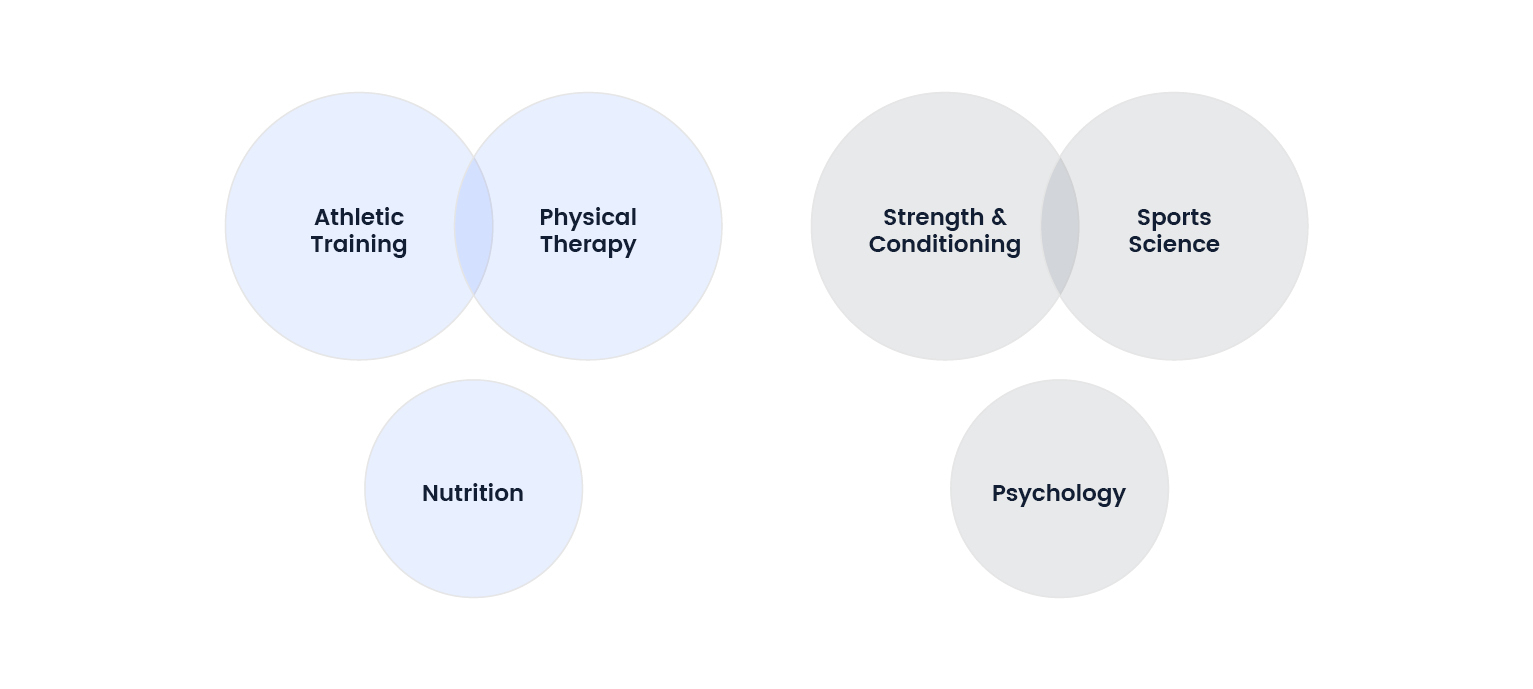
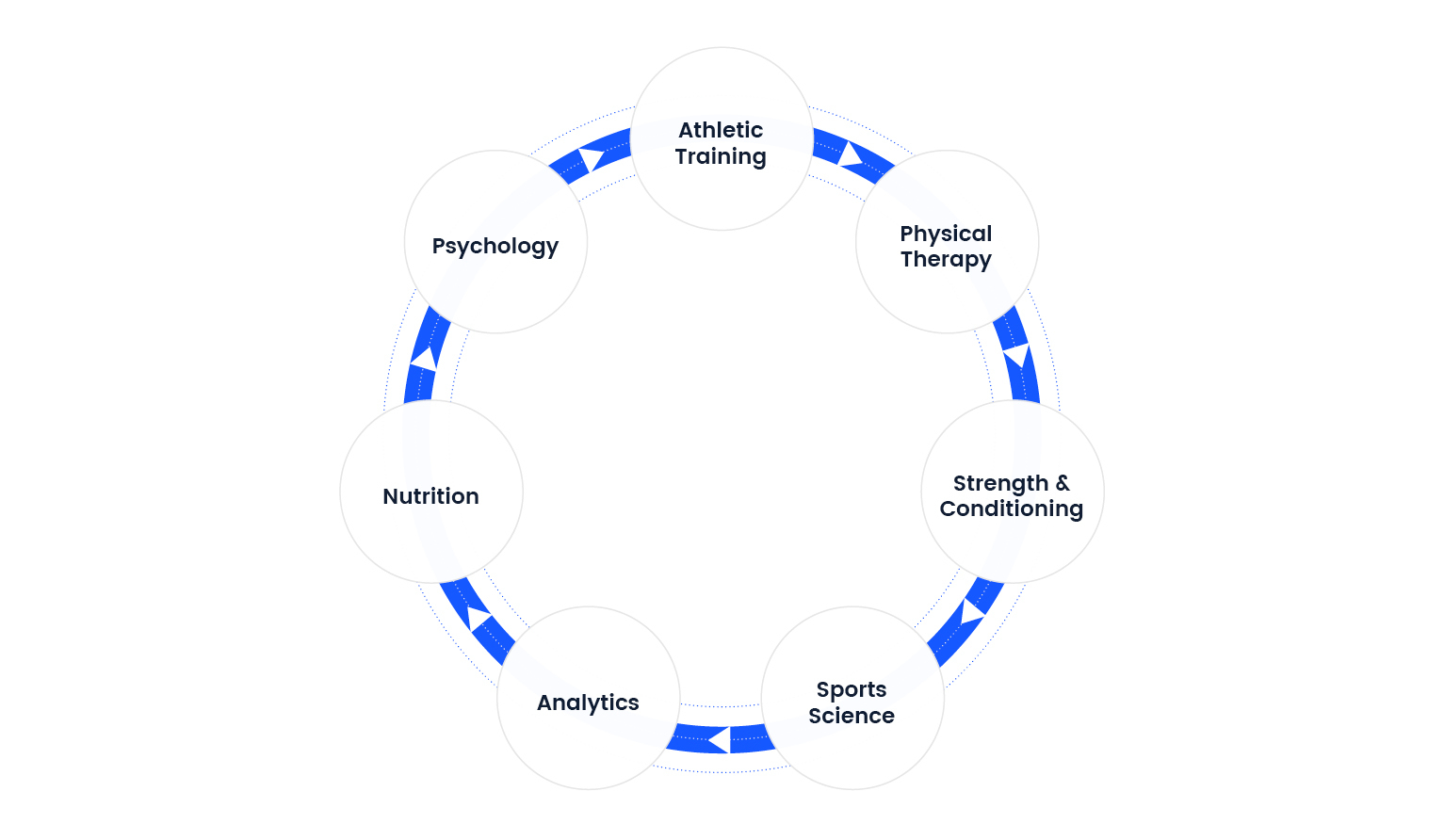
In Figure 1, there is a potential risk that this model can create a fragmented approach within the medical and performance department, impacting collaboration and service delivery. Therefore, in order to remove silos and low cohesion amongst departments, teams have adopted an approach to hiring a strategic leader to oversee and integrate the domains to reflect in Figure 2. For purposes of this paper, the title of Head of Medical and Performance will be used to describe the strategic leader overseeing both the medical and performance functions. It is important to recognize that there are a number of titles that currently exist inside a front office structure such as a 'High-Performance Director', 'Vice President of Medicine and Performance’ or a 'Chief of Athlete Care and Performance' which reflect this position but at the same time creates confusion and raises questions as to what does the role actually entail? Such variation in title can often impact the job description and create a lack of clarity around the function of the role for front office decision makers. Questions arise as to what domains they oversee, who they manage and what is the level of interaction with an athlete. What background do I hire for? However, it is important that senior leaders ask themselves - what are we trying to solve? What are the existing pains? Where are the challenges? What are the gaps? The issues confronting a franchise will vary considerably from one to the next, so it is critical to be self-reflective and solve the underlying pains. An NHL team may suffer from an ever-growing injury crisis, while an NBA team may be faced with poor interdisciplinary issues and a perceived lack of leadership. Both scenarios may require a different solution and a different type of profile. It is important to acknowledge that irrespective of an individual’s background (i.e medical, performance, psychology) the role has a strong focus on creating clear leadership at the top of the support service area for Ownership and Front Office to collaborate with around injuries, return to play, and general performance review of key players, overseeing an integrated departmental vision and strategy, and creating a clear medical and performance model for all players, coaches, and staff to buy-into. The figure below highlights how the role would fit within a front office.
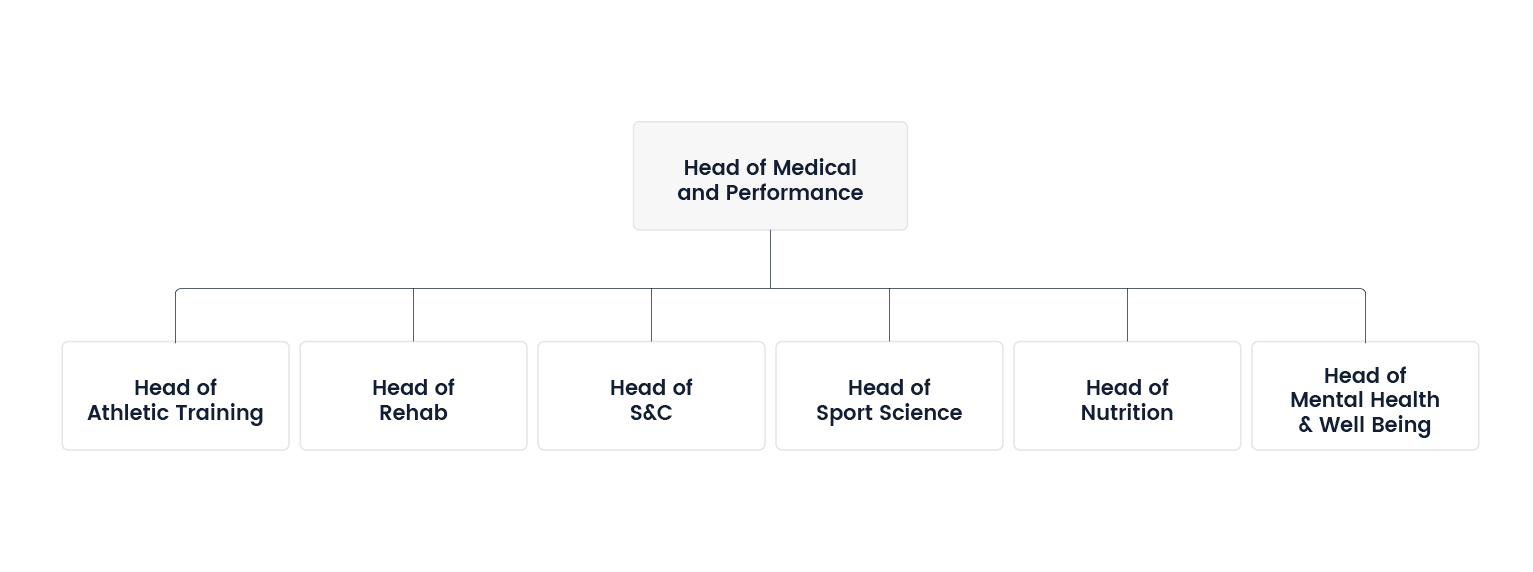
Three areas have been highlighted below where having a Head of Medical and Performance role inside a front office structure could prove valuable in order to drive organizational outcome.
Strategic Alignment: To determine impact, understand the vision
Problem-solving in an environment where there are multiple competing priorities is a mindset every medical and performance leader must adopt. The role of a medical and performance leader is multifunctional in nature and is expected to think critically, making informed decisions that will positively impact the organization in the short, medium, and long term. It requires the ability to delicately balance a diverse set of stakeholders while developing and implementing strategies that impact organizational outcomes. Inside every organization, an Owner, CEO, General Manager, and Head Coach will have different perspectives, demands, and ambitions, and decisions will be dictated and impacted by the information delivered through this role. An owner is focused on the overall success and financial well-being of their organization where they have a vested interest in the team's profitability and long-term sustainability. They expect to see an ROI on their investment. The CEO is responsible for the organization's overall strategy, operations, and financial performance with a strong focus on maximizing revenue. They will want to know the availability status for marketing and commercial opportunities which will build brand awareness. A General Manager's main focus is creating a championship-caliber roster that is constantly looking to improve. Often questions are centered on the risk associated with drafting, trading, or signing a free agent. How will it affect the current roster dynamic? The Head Coach, who is focused on on-field performance, ultimately wants to know - ‘’are they ready’’ and ‘’can they play’’. If not, “why not”? With so many priorities facing multiple different stakeholders, the role of a Head of Medical and Performance leader is to clarify objectives and implement measurements that provide evidence based-insights for decision making. It is a role that requires consistent communication both vertically and horizontally where there is continual education around the information being shared so everyone is aligned on the next steps.
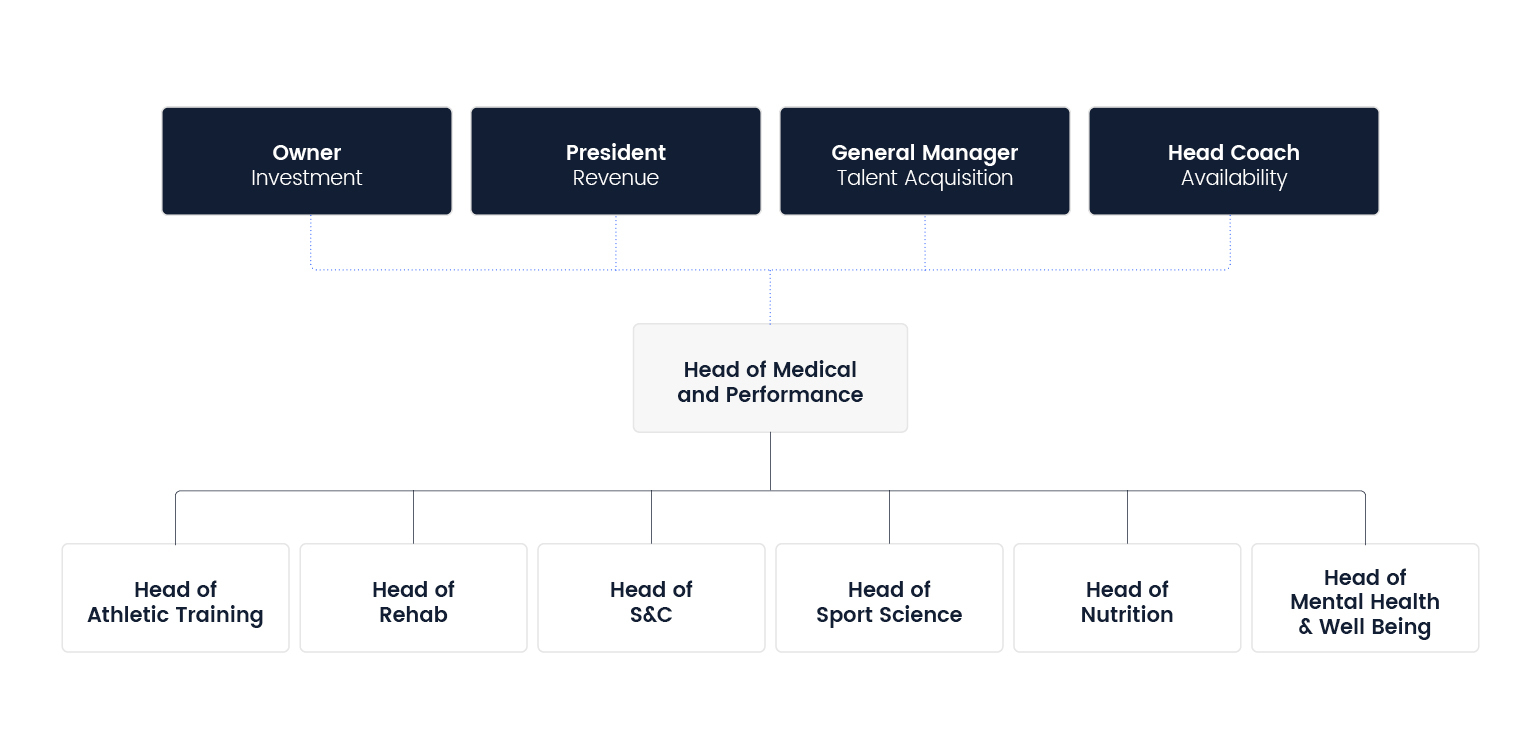
KPI’s: Defining and prioritizing what matters
The key areas of focus for every Head of Medical and Performance leader is on an athlete's ability to physically cope with the game’s demands and their ability to execute the game model. The role is therefore often responsible for identifying, evaluating, and categorizing the issues which are affecting outcomes and highlighting such findings to senior stakeholders. It is critical that the Head of Medical and Performance engages with Ownership, the General Manager, and/or the Head Coach to determine what are the highest priorities for the department to allocate resources on a daily, weekly and monthly basis to service and track progress. Providing clear, insight-driven updates as to how the department has addressed the problem, what was measured, and how it was tracked creates clarity and clear lines of communication where everyone has an opportunity to challenge and question all relevant details which affect their short, medium, and long-term needs. Acknowledging that there are factors such as the collective bargaining agreement which can make the role a little restrictive at times, it is important to build engagement with athletes to develop and instill confidence in the work being delivered. Utilizing metrics to build a detailed medical overview of an athlete, creates and sets expectations but also provides an opportunity to predict the injury risk associated with each athlete. Furthermore, setting an approach where the medical recommendations use a timeline-based approach can demonstrate to an Owner, CEO, General Manager, and Head Coach both the short and long-term risks and how it could potentially impact their respective functions. By implementing this process-orientated approach, it provides an opportunity to evaluate new problems and issues to fix with a prioritization on what the impact on performance will be.

Culture: To create accountability, create clarity
The Head of Medical and Performance will have a clear understanding of the overall organizational strategy where the success of the department will be dictated by their ability to clearly articulate how each domain will positively impact organizational outcome. Through this discovery process, a clear and measurable development plan can be implemented for each staff member where the demands and expectations of their role are clearly outlined. Developing clarity for the department will create accountability with the aim of fostering an open, collaborative, high-challenge but high-performing culture where there is a clear governance structure with a common purpose. Implementing a clear communication framework where information flows efficiently, creates an engaged and aligned staff where issues can be addressed and solutions can be determined on how to best serve the department goals and organizational objectives but more importantly best serve the athlete. Focusing on strategies that continually look to innovate through a team-focused approach, removes the risk of siloed thinking, and places a premium on collaboration. Furthermore, in an often highly emotionally charged environment, the role can bring a sense of prioritization and direction but more importantly a sense of connection between players, staff, and coaching. The ability to balance and translate different perspectives can instill a clear sense of focus, however, it requires the ability to create a supportive environment that on one level provides a level of security but on another, demands a need for exploration. Through this level of self-reflection, examining what change is needed will provide an ability to refine processes and drive innovation with purpose. In order to accelerate change, however, there needs to be consistency around the messaging so that everyone is aware of when change occurs, why it occurs, and the effect it will bring. Ultimately, every question should start with - does this maximize player availability?
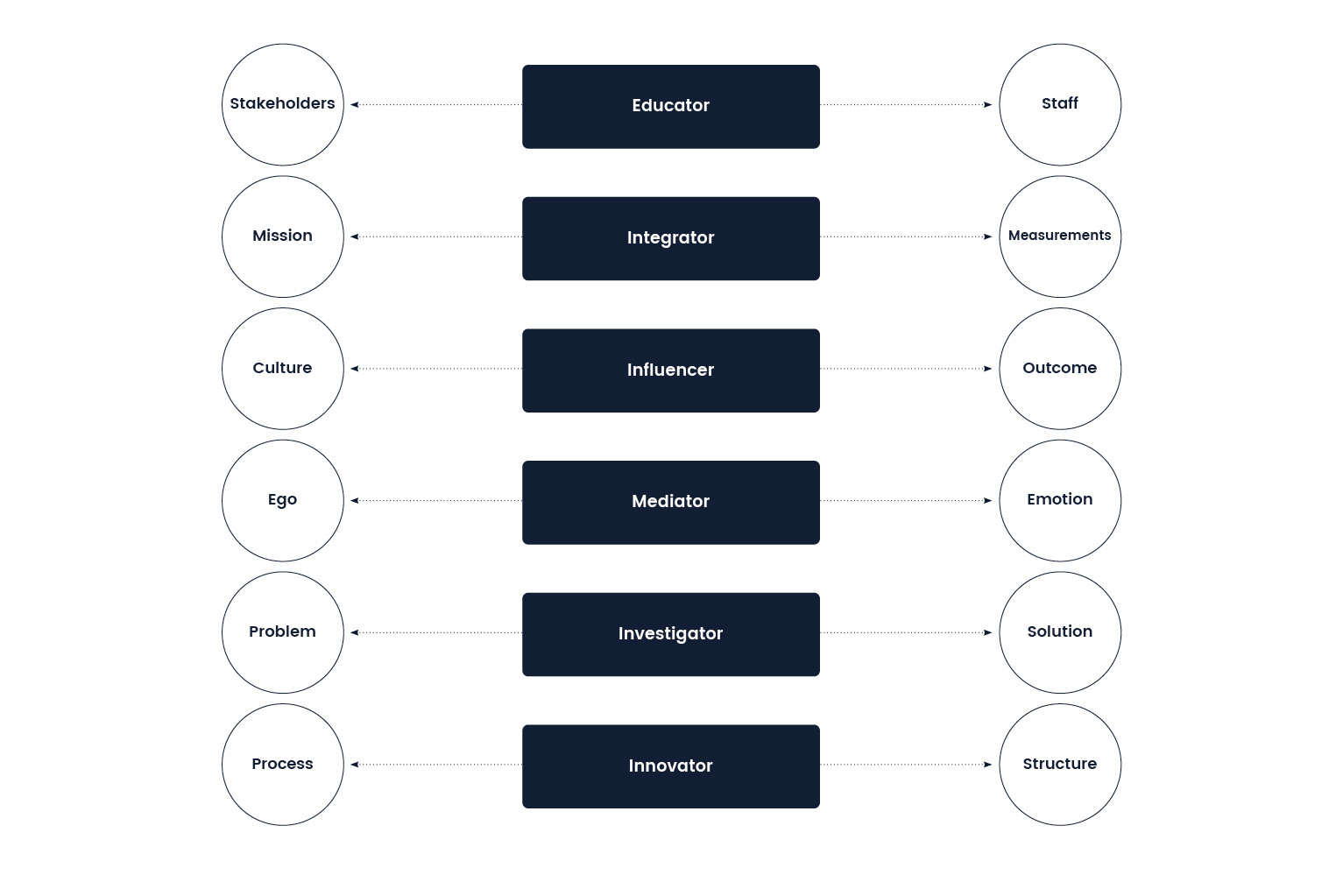
Conclusion
While acknowledging that the Head of Medical and Performance role is centered around optimizing player performance it is important to also look at the success of the role by assessing the environment where it maximizes the performance of organizational talent. This involves creating a high-performing culture with elite practitioners, executing in a clear framework that is collaborative in nature but clear in its purpose. The role should focus on creating a curriculum that best serves the organization in the short, medium, and long term where the ability to communicate and coordinate effectively will be based on a clear understanding of the organizational vision and objectives.

